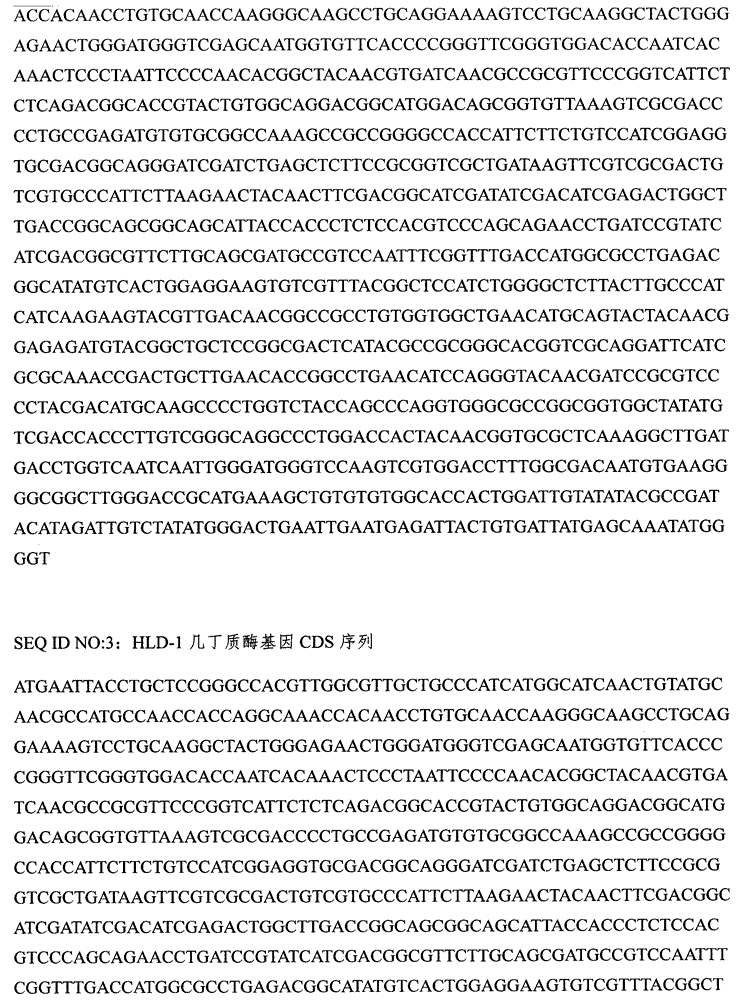Clonostachys rosea engineering strain for transforming chitinase gene, and applications thereof
A technology of chitinase gene and engineering strains, which is applied in genetic engineering, application, plant gene improvement, etc., can solve the problems of unstable control effect and limited disease resistance of Clonosporium pinkhelix, and achieve improved and stable control effect resistance, good control effect, and the effect of enhancing disease resistance
- Summary
- Abstract
- Description
- Claims
- Application Information
AI Technical Summary
Problems solved by technology
Method used
Image
Examples
Embodiment 1
[0021] Isolation and Identification of the Target Gene of Chitinase
[0022] The Clonosporium rosea HLD-1 strain was transferred to PDA medium. The composition of PDA medium was: potato 200g / L, glucose 20g / L, agar 20g / L, placed in a constant temperature incubator at 26°C for 7 days, Mycelium was collected with a spatula, DNA was extracted by CTAB method, and RNA was extracted by Trizol method. Using RNA as a template, cDNA was obtained using a cDNA reverse transcription kit.
[0023] Using DNA and cDNA sequences as templates, design primers at both ends of the target gene of chitinase, chiF (5′-3′): TTCAGAGTAGGCTTTTGGATTGGT, chiR: ACCCCATATTTGCTCATAATCACA, PCR amplifies chitinase DNA and cDNA respectively. PCR conditions were: pre-denaturation at 94°C for 4 minutes, followed by 30 cycles of denaturation at 94°C for 30 seconds, annealing at 55°C for 1 minute, and extension at 72°C for 2 minutes. Finally, it was kept at 72°C for 10 min to end the amplification reaction.
[00...
Embodiment 2
[0027] Construction and verification of chitinase overexpression vector
[0028] The promoter and terminator fragments were amplified from the target pAN7-1 vector, detected by agarose gel electrophoresis, and recovered by cutting the gel. The pEASY Uni Seamless Cloning and Assembly Kit was used to fuse and splice the linearized pAN7-1 vector and the chitinase target gene fragment to construct an overexpression vector. The constructed vector was transformed into Escherichia coli competent cells, cultured overnight at 37°C, clones were randomly selected to extract plasmids, and verified by HindIII digestion.
Embodiment 3
[0030] Preparation and Screening of Engineering Strain Cr-chi32
[0031] Clonosporium rosea HLD-1 was inoculated on PDA medium and cultured for 7 days until sporulation. The spores were eluted with sterile double distilled water, 1 ml was inoculated in PD liquid medium, and cultured at 26°C for 12 hours. Pass the bacterial solution through a 500-mesh sieve to collect the mycelia, wash with sterile water three times, then rinse with 0.7M sodium chloride osmotic pressure stabilizer to balance it, and collect the mycelium.
[0032] Use a sterile tip to pick the mycelium into the enzymatic hydrolysis solution containing 40mg / ml helicase, vortex fully, and enzymatically hydrolyze at 100r / min in a shaker at 28°C for 3h, and check the release of protoplasts every 1h. After enzymatic hydrolysis, add an equal volume of osmotic pressure stabilizer to dilute to avoid excessive enzymatic hydrolysis. Use miracloth to filter cell debris, transfer the filtrate to a 50ml centrifuge tube, cen...
PUM
 Login to View More
Login to View More Abstract
Description
Claims
Application Information
 Login to View More
Login to View More - R&D
- Intellectual Property
- Life Sciences
- Materials
- Tech Scout
- Unparalleled Data Quality
- Higher Quality Content
- 60% Fewer Hallucinations
Browse by: Latest US Patents, China's latest patents, Technical Efficacy Thesaurus, Application Domain, Technology Topic, Popular Technical Reports.
© 2025 PatSnap. All rights reserved.Legal|Privacy policy|Modern Slavery Act Transparency Statement|Sitemap|About US| Contact US: help@patsnap.com



